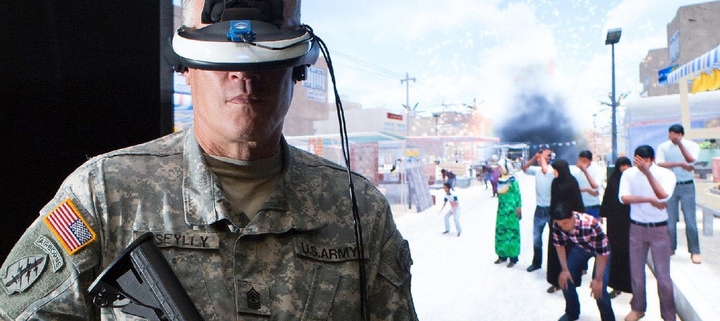Virtual reality research helps veterans with PTSD

When Chris Merkle retired from the U.S. Marine Corps in 2010, he struggled to overcome the lingering trauma of having served in Iraq and Afghanistan. While he met with a therapist regularly, Merkle found it difficult to share his overseas experience.
“I was not prepared or ready to deal with the trauma, so I just talked about surface-level problems,” Merkle said.
His therapist recommended the Bravemind project, which uses virtual reality technology to treat conditions like post-traumatic stress disorder. Patients are outfitted with a head-mounted virtual display and led by a therapist through a stress-inducing war environment. Participants physically hold a rifle as they experience a simulation that includes booming explosions and even smells of burning debris.
Dr. Albert Rizzo, director of Medical Virtual Reality at the USC Institute for Creative Technologies, created the first prototype of the therapy program in 2004. He began developing the project after recognizing the urgency to address PTSD for service members in Iraq and Afghanistan. According to a Research and Development Corporation study, nearly 20% of veterans returning from these conflicts report signs of PTSD.
“If you take the best technology … to teach people how to fight the war, we should be using the best technology to help people recover from wars,” Rizzo said.
Merkle credits the therapy program with helping him confront his trauma.
“It really just fast-forwarded my recovery because I had to deal with it and process it, and then I would take [the headset] off and realize ‘OK, I’m still in the hospital, and I’m OK,’” Merkle said.
Rizzo used the exposure therapy method to develop the project. Traditionally, PTSD patients in exposure therapy repeatedly recount a traumatic event in graphic detail to a clinician. This allows them to confront and emotionally reprocess harrowing memories.
“If you help a patient to go back to the scene of the crime emotionally or mentally and do it repeatedly, while it’s anxiety-provoking at first, eventually, the anxiety starts to extinguish or dissipate,” Rizzo said.
According to Rizzo, traditional exposure therapy has limits as therapists struggle to manage the patients’ imagination of a scenario.
“Basically you’re asking someone who spent months, years, sometimes decades trying to avoid thinking about what we’re asking them to pull up and imagine in great detail,” Rizzo said. “We never know if they’re really doing it.”
The Bravemind project offers a solution, exposing patients to a customized virtual experience that reflects the traumatic memory, Rizzo said. The current version includes 14 worlds for participants to choose from, including an Afghan village and Iraqi marketplace.
Clinicians operate the patient’s experience from a control panel to personalize the virtual setting. As the patient describes a traumatic memory, the therapist can adjust the time of day or include specific sounds to trigger an anxiety-inducing response.
Thomas Talbot began working as the medical expert for Bravemind in 2011. As a former army doctor, he emphasized the realism of the virtual scenarios.
“It’s more than just looking at a picture,” Talbot said. “It’s something that you viscerally feel.”
The original Bravemind prototype used art elements from the video game “Full Spectrum Warrior” to create a single-world system for soldiers on the ground in Iraq.
Following positive feedback overseas, the Office of Naval Research funded a clinical version of the system in 2005. Bravemind has since expanded to over 100 different clinical centers but is used primarily in veterans affairs hospitals and military bases.
The project has received funding from Dell Computers, Intel, Samsung Electronics and the SoldierStrong Foundation. Talbot said he hopes to reduce the amount of equipment needed for treatment, making the system more accessible to clinicians.
Brian Femminella, a sophomore majoring in political science and intelligence and cyber operations, will intern at the Bravemind project this summer. Femminella said he wants to collaborate with Rizzo to create an app that combines music therapy with VR technology.
“We want to increase the exposure because some people are afraid to talk to counselors or are afraid to admit that they’re struggling,” Femminella said.
Merkle highlighted the relevance of the Bravemind project for younger generations of veterans who are wary of traditional talk therapy. Their grasp of newer technology helps ease the pressure of a stressful therapeutic method.
“It’s something that a lot of younger veterans are used to, playing video games and being well-versed in this [technology], and it’s backed by the elements of science,” Merkle said.

